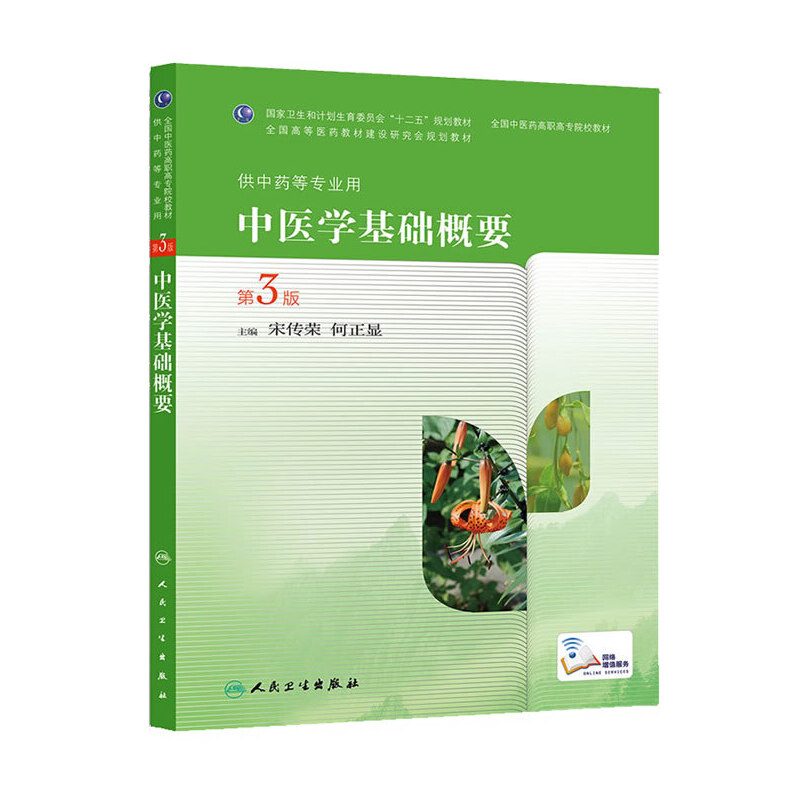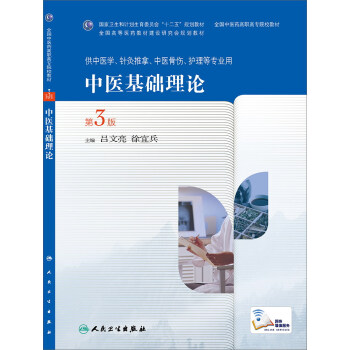中医基础理论(附光盘汉英对照) / 新世纪全国高等中医药院校创新教材
¥65.00定价
作者: 马淑然,刘兴仁
出版时间:2015-11
出版社:中国中医药出版社
- 中国中医药出版社
- 9787513217804
- 92869
- 2015-11
- R22
内容简介
马淑然、刘兴仁主编的《中医基础理论(附光盘汉英对照新世纪全国高等中医药院校创新教材)》主要特点在于:理论上保证中医理论体系的系统性、完整性、原创性;内容上继承与创新相结合,在溯本求源基础上,反映中医基础理论最新发展动态;文字上语言精练,通俗易懂,译文准确流畅,意译与直译结合;形式上除文字表述外,适当配图表、示意图,并首次采用段落式对照翻译,并对文化缺省和文化空缺做了脚注,书末还附有光盘,有标准的汉语和美式英语专家朗读的音频资料,便于中外读者的理解和学习。
目录
第一章 绪论Introduction
一、中医学的基本概念及其学科属性The Basic Concept of TCM and Its Discipline Feature
二、中医学理论体系的形成和发展Formation and Development of TCM Theoretical System
三、中医学的基本特点The Basic Characteristics of Theoretical System of TCM
四、中医学主要思维方法Major Thinking Methods of TCM
五、中医基础理论的主要内容及学习方法Main Contents and Learning Methods of TCM Foundations
第二章 中医哲学基础Philosophical Basis of TCM
第一节 阴阳学说Theory of Yin and Yang
一、阴阳学说的形成Formation of the Theory of Yin and Yang
二、阴阳学说的基本概念Basic Concept of the Theory of Yin and Yang
三、阴阳学说的基本内容Basic Contents ofthe Yin and yang Theory
四、阴阳学说在中医学中的应用Applications of the Yin and Yang Theory in TCM
第二节 五行学说Theory of the Five Elements
一、五行学说的形成Formation of the Theory of the Five Elements
二、五行学说的基本概念Basic Concept of the Theory of the Five Elements
三、五行学说的基本内容Basic Content of the Theory of the Five Elements
四、五行学说在中医学中的应用Application of the Theory of the Five Elements in TCM
第三章 藏象Visceral Manifestation
第一节 概说Introduction
一、藏象概念Concept of Visceral Manifestation
二、藏象学说形成Formation of the Visceral Manifestation Theory
三、脏腑分类及其生理特点Classification of Zang-fu Viscera and Their Physical Characteristics
四、藏象学说特点Characteristics of the Visceral Manifestation Theory
第二节 五脏Five Zang—viscera
一、心Heart
附:心包络appendix Pericardium
二、肺Lung
三、脾Spleen
四、肝Liver
五、肾Kidney
附:命门 appendix The Vital Gate
第三节 六腑Six Fu—viscera
一、胆Gallbladder
二、胃Stomach
三、小肠Small Intestine
四、大肠Large Intestine
五、膀胱Urinary Bladder
六、三焦Triple-jiao
第四节 奇恒之腑Extraordinary Viscera
一、脑Brain
二、女子胞Uterus
第五节 脏腑之间的关系Relationships among the Viscera
一、脏与脏之间的关系Relationships among the Five Zang—viscera
二、脏与腑之间的关系Relationships between Zang—viscera and Fu—viscera
三、腑与腑之间的关系Relationships among six Fu—viscera
第四章 精、气、血、津液Essence,Qi。Blood and Body Fluid
第一节精Essence
一、精的概念Concept of Essence
二、精的生成Production of Essence
三、精的贮藏与施泄Storage and Excretion of Essence
四、精的功能Functions of Essence
第二节 气Qi
一、气的基本概念Concept of Qi
二、气的生成Production of Qi
三、气的分类、分布与功能特点Classification,Distribution and Functional
Characteristics
四、气的生理功能Functions of Qi
五、气的运动Movement ofQi
第三血Blood
一、血的基本概念Concept of Blood
二、血的生成Production of Blood
三、血液的循行Circulation of Blood
四、血的功能Functions of Blood
第四节 津液Body Fluid
一、津液的基本概念Concept of Body Fluid
二、津液的生成、输布和排泄Formation,Distribution and Excretion of Body Fluid
三、津液的功能Physiological Function of Body Fluid
第五节 精气血津液之间的关系Relationships Among Essence,Qi,Blood and Body Fluid
一、精与气的关系Relationship between Essence and Qi
二、精与血的关系Relationship between Essence and Blood
三、精与津液的关系Relationship between Essence and Body Fluid
四、气和血的关系Relationship between Qi and Blood
五、气和津液的关系Relationship between Qi and Body Fluid
六、血和津液的关系Relationship between Blood and Body Fluid
第五章 经络Channels and Collaterals
第一节 经络的概念与经络系统的组成Concept and Composition of Channels and Collaterals
一、经络的概念Concept of Channels and Collaterals
二、经络系统的组成The Composition of Channel and Collateral System
第二节 十二经脉Twelve Regular Channels
一、名称分类Nomenclature and Classification
二、循行分布规律Pathways and Distribution of Channels and Collaterals
三、表里关系Interior—Exterior Relationships
四、流注次序Order of Cyclical Flow
五、循行部位Running Routes of Twelve Channels
第三节 奇经八脉Eight Extraordinary Channels(Vessels)
一、奇经八脉的概念及特点Concepts and Characteristics of Eight Extraordinary Channels(Vessels)
二、奇经八脉的生理功能Physiological Functions of Eight Extraordinary Channels(Vessels)
三、奇经八脉的循行部位及功能特点The Running Route and Functional Chara cteristics of Eight Extraordinary Channels(Vessels)
第四节 经别、别络、经筋、皮部Channel Divergence,Divergent Collaterals,Channel Sinews and Cutaneous Regions
一、十二经别Channel Divergences
二、十五别络Fifteen Divergent Collaterals
三、十二经筋Twelve Channel Sinews
四、十二皮部Cutaneous Regions
第五节 经络的生理功能Physiological Functions of the Channels and Collaterals
一、沟通联络作用Communicating and Connecting All Pans of the Body
二、运输气血作用Conveying Qi and Blood to Nourish the Whole Body
三、感应传导作用Reaction and Conduction
四、调节平衡作用Regulating Functional Balance for the Body
第六节 经络学说的临床应用Application of the Channel—collateral Theory
一、阐释病理变化Expounding Pathological Changes
二、指导临床诊断Guiding the Diagnosis of Diseases
三、指导疾病治疗Guiding Clinical Treatment
第六章 病因与发病Causes and Onset of Diseases
第一节 病因Causes of Diseases
一、外感性致病因素Exogenous Pathogenic Factors
二、内伤性致病因素Endogenous Pathogenic Factors
三、病理产物性致病因素Pathogens from Pathological Products
四、其他致病因素Other Pmhogens
第二节 发病Onset of Diseases
一、发病的基本原理Basic Principles of the Onset of Diseases
二、影响发病的主要因素Main Factors Influencing the Onset of Diseases
第七章 病机Pathological Mechanism
第一节 概说General Introduction
一、中医病机学说的概念Concept of the Theory of Pathological Mechanism in TCM
二、病机学说的整体观和辩证观Holistic—dialectical Concept of the Theory of Pathological Mechanism
第二节 基本病机Basic Pathological Mechanism
一、邪正盛衰Prosperity and Decline of the Evil—Qi and Healthy—Qi
二、阴阳失调Imbalance Between Yin and Yang
三、气血失常Disorders of Qi and Blood
四、津液代谢失常Abnormal Metabolism of Body Fluids
第三节 内生“五邪”病机The Pathological Mechanism of Five Endogenous Evils
一、风气内动Wind—qi Stirring Within
二、寒从中生Cold Originating from Interior
三、湿浊内生Damp—turbidity Originating from Interior
四、津伤化燥Impairment of Body Fluids Transformed into Dryness
五、火热内生Heat or Fire Originating from Interior
第八章 防治原则Principles for Prevention and Treatment
第一节 预防Prevention
一、未病先防Pre—disease Prevention
二、既病防变In—disease Prevention of Transformation
第二节 治则Treatment Principle
一、治病求本Treating the Root Causes of Diseases
二、扶正祛邪Supporting Healthy Qi and Eliminating Evil—qi
三、调整阴阳Restoring Balance Between Yin and Yang
四、调理气血Adjusting and Rectifying Qi and Blood
五、三因制宜Treatment Individualized to Season.Locality and Patient
附录1 关键名词术语对照表Key Words
附录2 主要参考书目Bibliography
一、中医学的基本概念及其学科属性The Basic Concept of TCM and Its Discipline Feature
二、中医学理论体系的形成和发展Formation and Development of TCM Theoretical System
三、中医学的基本特点The Basic Characteristics of Theoretical System of TCM
四、中医学主要思维方法Major Thinking Methods of TCM
五、中医基础理论的主要内容及学习方法Main Contents and Learning Methods of TCM Foundations
第二章 中医哲学基础Philosophical Basis of TCM
第一节 阴阳学说Theory of Yin and Yang
一、阴阳学说的形成Formation of the Theory of Yin and Yang
二、阴阳学说的基本概念Basic Concept of the Theory of Yin and Yang
三、阴阳学说的基本内容Basic Contents ofthe Yin and yang Theory
四、阴阳学说在中医学中的应用Applications of the Yin and Yang Theory in TCM
第二节 五行学说Theory of the Five Elements
一、五行学说的形成Formation of the Theory of the Five Elements
二、五行学说的基本概念Basic Concept of the Theory of the Five Elements
三、五行学说的基本内容Basic Content of the Theory of the Five Elements
四、五行学说在中医学中的应用Application of the Theory of the Five Elements in TCM
第三章 藏象Visceral Manifestation
第一节 概说Introduction
一、藏象概念Concept of Visceral Manifestation
二、藏象学说形成Formation of the Visceral Manifestation Theory
三、脏腑分类及其生理特点Classification of Zang-fu Viscera and Their Physical Characteristics
四、藏象学说特点Characteristics of the Visceral Manifestation Theory
第二节 五脏Five Zang—viscera
一、心Heart
附:心包络appendix Pericardium
二、肺Lung
三、脾Spleen
四、肝Liver
五、肾Kidney
附:命门 appendix The Vital Gate
第三节 六腑Six Fu—viscera
一、胆Gallbladder
二、胃Stomach
三、小肠Small Intestine
四、大肠Large Intestine
五、膀胱Urinary Bladder
六、三焦Triple-jiao
第四节 奇恒之腑Extraordinary Viscera
一、脑Brain
二、女子胞Uterus
第五节 脏腑之间的关系Relationships among the Viscera
一、脏与脏之间的关系Relationships among the Five Zang—viscera
二、脏与腑之间的关系Relationships between Zang—viscera and Fu—viscera
三、腑与腑之间的关系Relationships among six Fu—viscera
第四章 精、气、血、津液Essence,Qi。Blood and Body Fluid
第一节精Essence
一、精的概念Concept of Essence
二、精的生成Production of Essence
三、精的贮藏与施泄Storage and Excretion of Essence
四、精的功能Functions of Essence
第二节 气Qi
一、气的基本概念Concept of Qi
二、气的生成Production of Qi
三、气的分类、分布与功能特点Classification,Distribution and Functional
Characteristics
四、气的生理功能Functions of Qi
五、气的运动Movement ofQi
第三血Blood
一、血的基本概念Concept of Blood
二、血的生成Production of Blood
三、血液的循行Circulation of Blood
四、血的功能Functions of Blood
第四节 津液Body Fluid
一、津液的基本概念Concept of Body Fluid
二、津液的生成、输布和排泄Formation,Distribution and Excretion of Body Fluid
三、津液的功能Physiological Function of Body Fluid
第五节 精气血津液之间的关系Relationships Among Essence,Qi,Blood and Body Fluid
一、精与气的关系Relationship between Essence and Qi
二、精与血的关系Relationship between Essence and Blood
三、精与津液的关系Relationship between Essence and Body Fluid
四、气和血的关系Relationship between Qi and Blood
五、气和津液的关系Relationship between Qi and Body Fluid
六、血和津液的关系Relationship between Blood and Body Fluid
第五章 经络Channels and Collaterals
第一节 经络的概念与经络系统的组成Concept and Composition of Channels and Collaterals
一、经络的概念Concept of Channels and Collaterals
二、经络系统的组成The Composition of Channel and Collateral System
第二节 十二经脉Twelve Regular Channels
一、名称分类Nomenclature and Classification
二、循行分布规律Pathways and Distribution of Channels and Collaterals
三、表里关系Interior—Exterior Relationships
四、流注次序Order of Cyclical Flow
五、循行部位Running Routes of Twelve Channels
第三节 奇经八脉Eight Extraordinary Channels(Vessels)
一、奇经八脉的概念及特点Concepts and Characteristics of Eight Extraordinary Channels(Vessels)
二、奇经八脉的生理功能Physiological Functions of Eight Extraordinary Channels(Vessels)
三、奇经八脉的循行部位及功能特点The Running Route and Functional Chara cteristics of Eight Extraordinary Channels(Vessels)
第四节 经别、别络、经筋、皮部Channel Divergence,Divergent Collaterals,Channel Sinews and Cutaneous Regions
一、十二经别Channel Divergences
二、十五别络Fifteen Divergent Collaterals
三、十二经筋Twelve Channel Sinews
四、十二皮部Cutaneous Regions
第五节 经络的生理功能Physiological Functions of the Channels and Collaterals
一、沟通联络作用Communicating and Connecting All Pans of the Body
二、运输气血作用Conveying Qi and Blood to Nourish the Whole Body
三、感应传导作用Reaction and Conduction
四、调节平衡作用Regulating Functional Balance for the Body
第六节 经络学说的临床应用Application of the Channel—collateral Theory
一、阐释病理变化Expounding Pathological Changes
二、指导临床诊断Guiding the Diagnosis of Diseases
三、指导疾病治疗Guiding Clinical Treatment
第六章 病因与发病Causes and Onset of Diseases
第一节 病因Causes of Diseases
一、外感性致病因素Exogenous Pathogenic Factors
二、内伤性致病因素Endogenous Pathogenic Factors
三、病理产物性致病因素Pathogens from Pathological Products
四、其他致病因素Other Pmhogens
第二节 发病Onset of Diseases
一、发病的基本原理Basic Principles of the Onset of Diseases
二、影响发病的主要因素Main Factors Influencing the Onset of Diseases
第七章 病机Pathological Mechanism
第一节 概说General Introduction
一、中医病机学说的概念Concept of the Theory of Pathological Mechanism in TCM
二、病机学说的整体观和辩证观Holistic—dialectical Concept of the Theory of Pathological Mechanism
第二节 基本病机Basic Pathological Mechanism
一、邪正盛衰Prosperity and Decline of the Evil—Qi and Healthy—Qi
二、阴阳失调Imbalance Between Yin and Yang
三、气血失常Disorders of Qi and Blood
四、津液代谢失常Abnormal Metabolism of Body Fluids
第三节 内生“五邪”病机The Pathological Mechanism of Five Endogenous Evils
一、风气内动Wind—qi Stirring Within
二、寒从中生Cold Originating from Interior
三、湿浊内生Damp—turbidity Originating from Interior
四、津伤化燥Impairment of Body Fluids Transformed into Dryness
五、火热内生Heat or Fire Originating from Interior
第八章 防治原则Principles for Prevention and Treatment
第一节 预防Prevention
一、未病先防Pre—disease Prevention
二、既病防变In—disease Prevention of Transformation
第二节 治则Treatment Principle
一、治病求本Treating the Root Causes of Diseases
二、扶正祛邪Supporting Healthy Qi and Eliminating Evil—qi
三、调整阴阳Restoring Balance Between Yin and Yang
四、调理气血Adjusting and Rectifying Qi and Blood
五、三因制宜Treatment Individualized to Season.Locality and Patient
附录1 关键名词术语对照表Key Words
附录2 主要参考书目Bibliography




